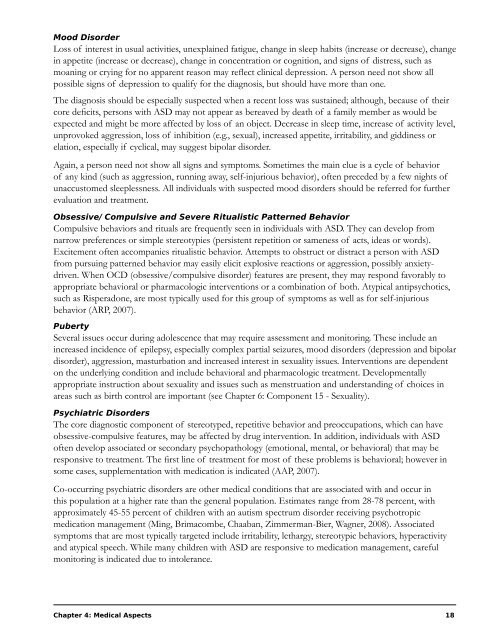Autism Guidebook for Washington State - Health Education ...
Autism Guidebook for Washington State - Health Education ...
Autism Guidebook for Washington State - Health Education ...
You also want an ePaper? Increase the reach of your titles
YUMPU automatically turns print PDFs into web optimized ePapers that Google loves.
Mood Disorder<br />
Loss of interest in usual activities, unexplained fatigue, change in sleep habits (increase or decrease), change<br />
in appetite (increase or decrease), change in concentration or cognition, and signs of distress, such as<br />
moaning or crying <strong>for</strong> no apparent reason may reflect clinical depression. A person need not show all<br />
possible signs of depression to qualify <strong>for</strong> the diagnosis, but should have more than one.<br />
The diagnosis should be especially suspected when a recent loss was sustained; although, because of their<br />
core deficits, persons with ASD may not appear as bereaved by death of a family member as would be<br />
expected and might be more affected by loss of an object. Decrease in sleep time, increase of activity level,<br />
unprovoked aggression, loss of inhibition (e.g., sexual), increased appetite, irritability, and giddiness or<br />
elation, especially if cyclical, may suggest bipolar disorder.<br />
Again, a person need not show all signs and symptoms. Sometimes the main clue is a cycle of behavior<br />
of any kind (such as aggression, running away, self-injurious behavior), often preceded by a few nights of<br />
unaccustomed sleeplessness. All individuals with suspected mood disorders should be referred <strong>for</strong> further<br />
evaluation and treatment.<br />
Obsessive/Compulsive and Severe Ritualistic Patterned Behavior<br />
Compulsive behaviors and rituals are frequently seen in individuals with ASD. They can develop from<br />
narrow preferences or simple stereotypies (persistent repetition or sameness of acts, ideas or words).<br />
Excitement often accompanies ritualistic behavior. Attempts to obstruct or distract a person with ASD<br />
from pursuing patterned behavior may easily elicit explosive reactions or aggression, possibly anxietydriven.<br />
When OCD (obsessive/compulsive disorder) features are present, they may respond favorably to<br />
appropriate behavioral or pharmacologic interventions or a combination of both. Atypical antipsychotics,<br />
such as Risperadone, are most typically used <strong>for</strong> this group of symptoms as well as <strong>for</strong> self-injurious<br />
behavior (ARP, 2007).<br />
Puberty<br />
Several issues occur during adolescence that may require assessment and monitoring. These include an<br />
increased incidence of epilepsy, especially complex partial seizures, mood disorders (depression and bipolar<br />
disorder), aggression, masturbation and increased interest in sexuality issues. Interventions are dependent<br />
on the underlying condition and include behavioral and pharmacologic treatment. Developmentally<br />
appropriate instruction about sexuality and issues such as menstruation and understanding of choices in<br />
areas such as birth control are important (see Chapter 6: Component 15 - Sexuality).<br />
Psychiatric Disorders<br />
The core diagnostic component of stereotyped, repetitive behavior and preoccupations, which can have<br />
obsessive-compulsive features, may be affected by drug intervention. In addition, individuals with ASD<br />
often develop associated or secondary psychopathology (emotional, mental, or behavioral) that may be<br />
responsive to treatment. The first line of treatment <strong>for</strong> most of these problems is behavioral; however in<br />
some cases, supplementation with medication is indicated (AAP, 2007).<br />
Co-occurring psychiatric disorders are other medical conditions that are associated with and occur in<br />
this population at a higher rate than the general population. Estimates range from 28-78 percent, with<br />
approximately 45-55 percent of children with an autism spectrum disorder receiving psychotropic<br />
medication management (Ming, Brimacombe, Chaaban, Zimmerman-Bier, Wagner, 2008). Associated<br />
symptoms that are most typically targeted include irritability, lethargy, stereotypic behaviors, hyperactivity<br />
and atypical speech. While many children with ASD are responsive to medication management, careful<br />
monitoring is indicated due to intolerance.<br />
Chapter 4: Medical Aspects 18
















